
08/05/2012
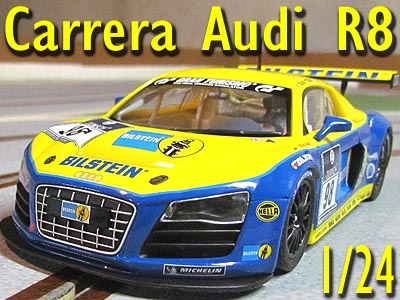
Carrera Audi R8 1:24 Scale “Team Phoenix”
Good things come in bigger packages, too
By Kurt “El Secundo” Moser
Carrera has been putting out 1:24 cars for years and years, and they have often found themselves stuck in the middle -- either they aren’t respected by the more traditional 1:24 commercial track crowd, or not taken seriously by the more scale-oriented 1:32 scale basement dwellers. But Carrera has steadily improved their cars over the years, while building a broader range of 1:24 choices. Carrera has recently added the Audi R8 GT3 LMS, and we’ll take a look at the Team Phoenix car.
Carrera starts on the right foot with a beautifully modeled car, and where you won’t get a ton of photo-etched bits and antennae sticking out all over the car, what you do get is a realistic and true-to-life paint job on properly proportioned bodywork. It looks good from 10 feet, it looks good from 2 feet. Not surprisingly, it brings the same level of detail as Carrera’s 1:32 cars, so if you like those, then this car should make you happy.
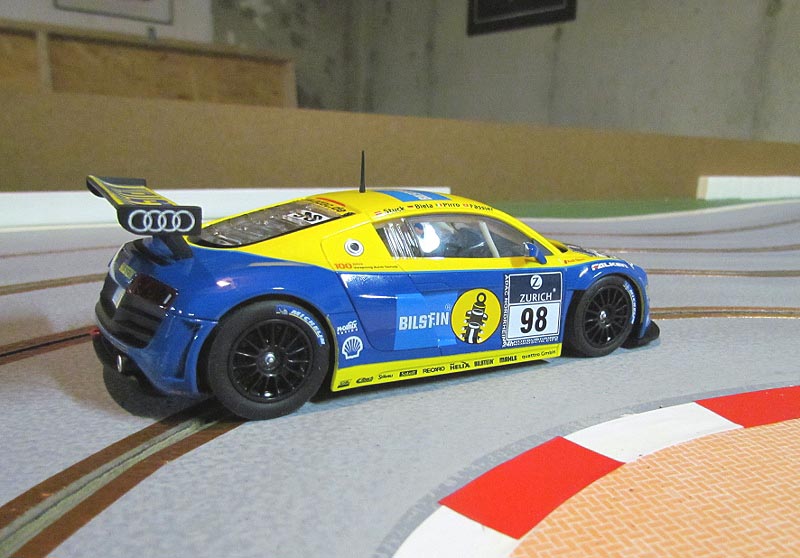
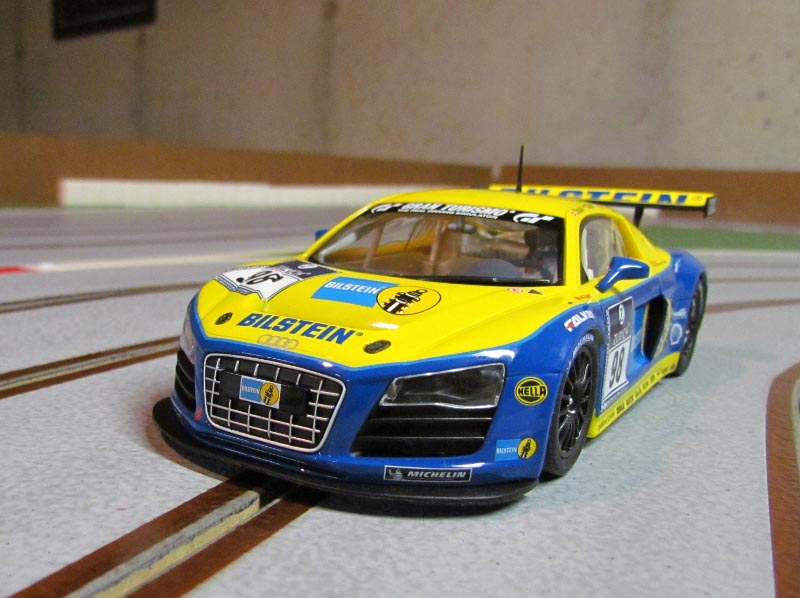
My only complaint in the appearance department is that the yellow has a bit of a translucent but shiny look to it, which gives the car a slightly ‘plastic’ appearance. I’ve seen better, and I’ve seen worse, but the overall appearance is really pretty good. I’d give it about a ‘B’. Mind you, I had this car in my hands at the shop, so I was looking directly at it before deciding to plunk down the dollars. Believe me, if the paint was bad, it would have stayed on the shelf. Also, Carrera has seen fit to protect the rear wing during shipping with a vac-formed plastic insert, Slot.It style. To be honest, I do have a question about how this wing will hold up under race conditions. The attachment points are narrow, and a good hit may take it right off. Carrera 1:24 cars are generally pretty rugged, but it wouldn’t hurt to keep your favorite glue handy.
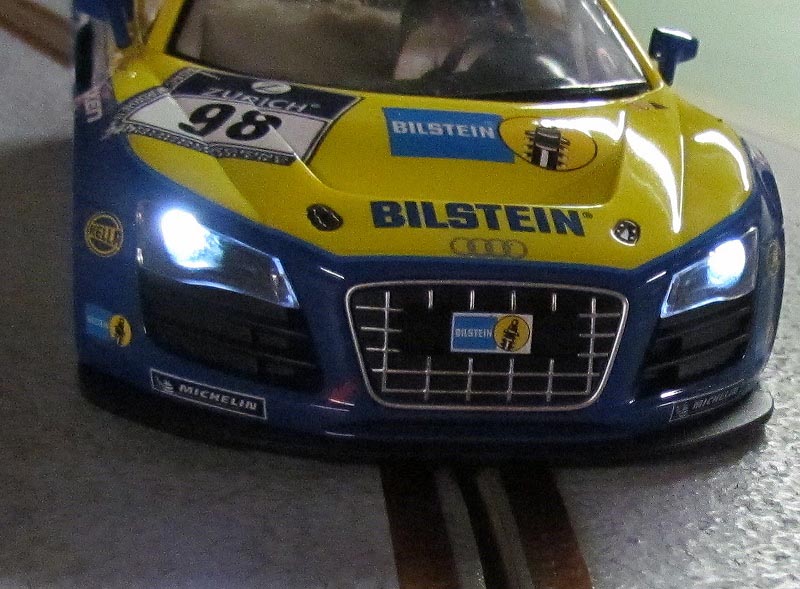
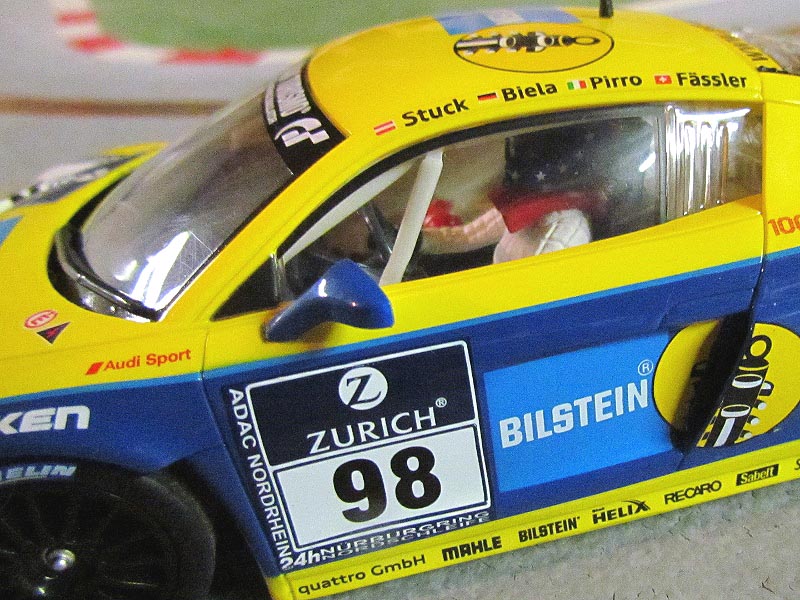
Carrera’s digital 1:24 cars need one small change before running on analog track. Flip the tiny switch on the bottom of the car, put the car on the track, and pull the trigger three times. This is all that’s needed to switch to analog from digital mode. Carrera deserves a lot of credit for this, because it can’t get much simpler. Well, enjoy that simplicity while you, because it ends right there.
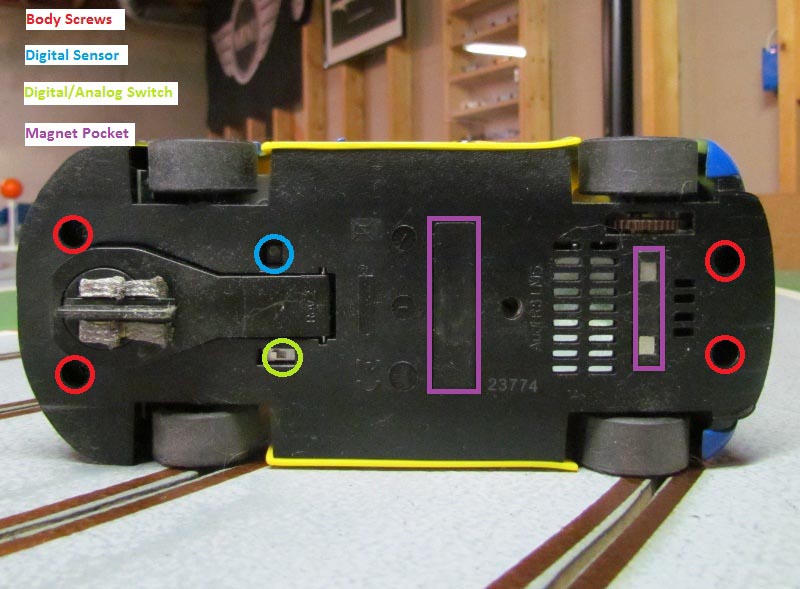
Maybe you’re familiar with a guy named ‘Rube Goldberg’. Famous for devising ultra-complex devices to do basics tasks like turning on a light switch, and the inspiration for the old game ‘Mouse Trap’, Rube passed away in 1970. His spirit has apparently possessed the lead engineer at Carrera, as this chassis is definitely on the unnecessarily complicated side. When he put pen to paper to lay out the design parameters for his team, the design parameters may have been:
1) 1. Use way more parts than necessary
2) 2. Must weigh more than a brick
3) 3. Make sure nobody can figure out what the parts are supposed to do
And….mission accomplished! Disassembling the car was like the slot car version of watching ‘Alien Autopsy’. Never really sure what anything was or what it was doing there, pieces were removed and photos taken before dropping them into a bucket.
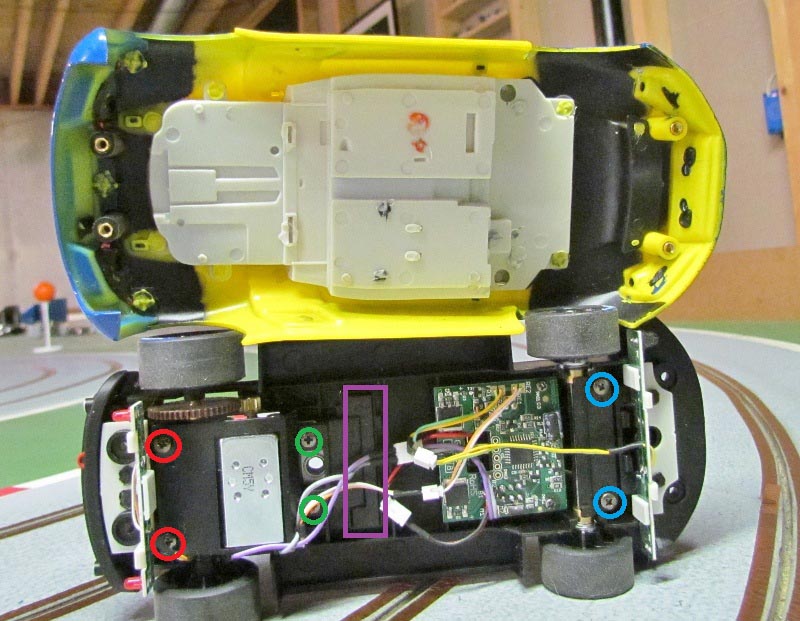
Rummaging through the bucket of guts revealed an interesting central magnet pocket. Now, if you were Carrera, you could mold your chassis to accept a magnet and be done with it. Or, you could leave a large hole in the chassis, and use a complex set of three plastic pieces, plus a shim, plus a magnet, plus two screws to hold it all together. Pure simplicity!
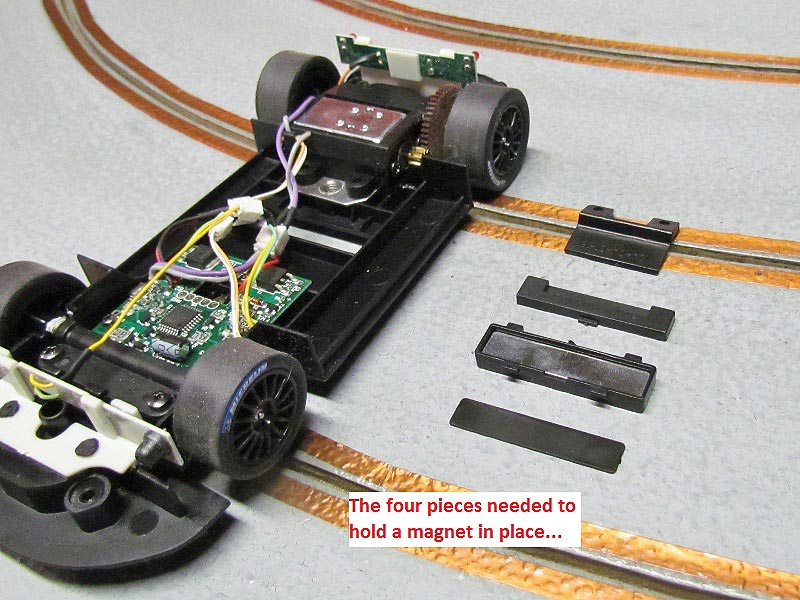
It wasn’t always this way. Carrera 1:24 cars used to have their magnets mounted on the bottom of the car by screws, but it seems that European toy regulations have forced them to devise a strategy for mounting magnets internally. Carrera took this to heart, and was apparently determined to keep anyone from extracting the magnets without anything short of a chainsaw, hand grenade, or secret decoder ring.
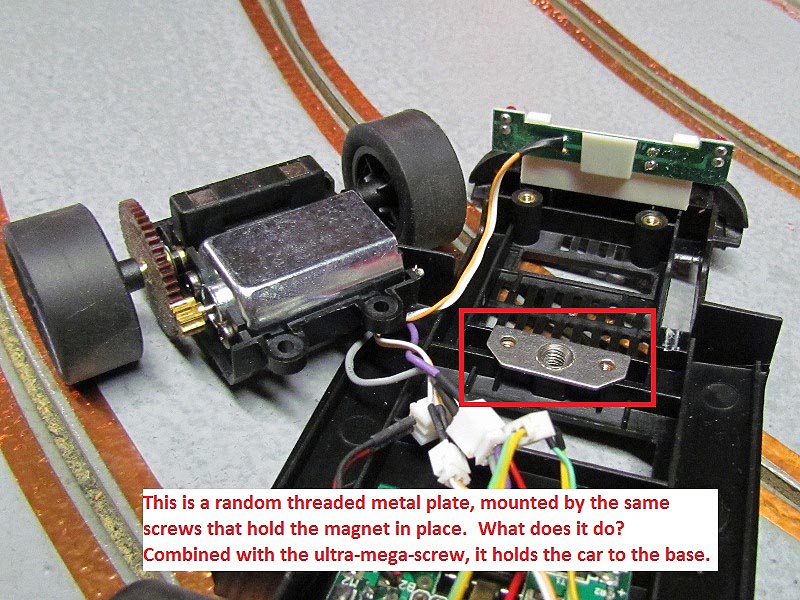
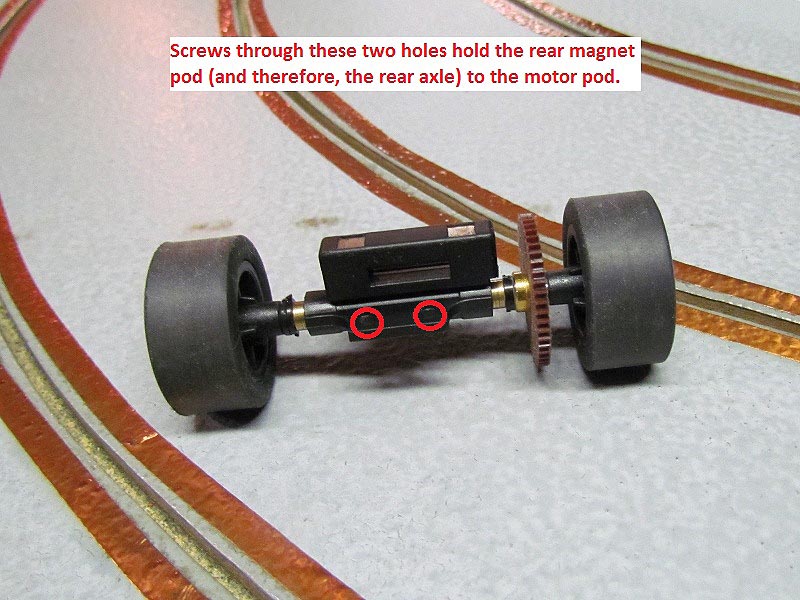
The rear magnet is mounted in an equally odd way. This time, it’s in a sleeve that holds the rear bushings, and this sleeve is mounted on the rear axle itself. So when you remove the rear axle/wheel assembly, you also have an axle-length sleeve with a magnet inside it. Two more screws on this sleeve will free yet another random plastic piece, giving you access to this mobile magnet pod. To swallow the rear magnet, a child would probably need to swallow the entire rear axle assembly with the wheels, tires, and 50-tooth spur gear. If they can accomplish that, the magnet may be the least of their worries. “Junior, have you seen the rear axle from my Audi? And why are you stuck to the refrigerator?”
After an amusing reassembly, it was time to put the car on the track, first at 12 volts, then at 18 volts (the recommended voltage for Carrera 1:24 cars).
At 12 volts: nothing to report. The headlights look pretty, but the car doesn’t get enough juice to do anything interesting. At 18 volts: this is more like it! The Audi is very smooth on the wood track, though the currently un-trued tires are a bit on the slippery side. The drive is predictable, with a nice little slide. Acceleration is decent, despite hauling around the entire hardware section from Home Depot. Brakes work well, and all in all, the Audi behaves like a middle-of-the-road 1:32 car that’s smooth out of the box. Criticism? Not hardly. All that weight gives the R8 a more realistic drive, which is a big selling point for fans of this series of cars. Where many 1:32 cars provide almost instantaneous responses to each input from the driver, the 1:24 Audi behaves more like a real car, with real weight to it. Having run digital 1:24 Carrera before, this car should be a good match to the Aston Martins, the Porsche 997s and the Corvette C6Rs, with similar speed and handling characteristics. With the shims and the variety of magnets, it’s fairly easy to adjust these cars to match their speeds.
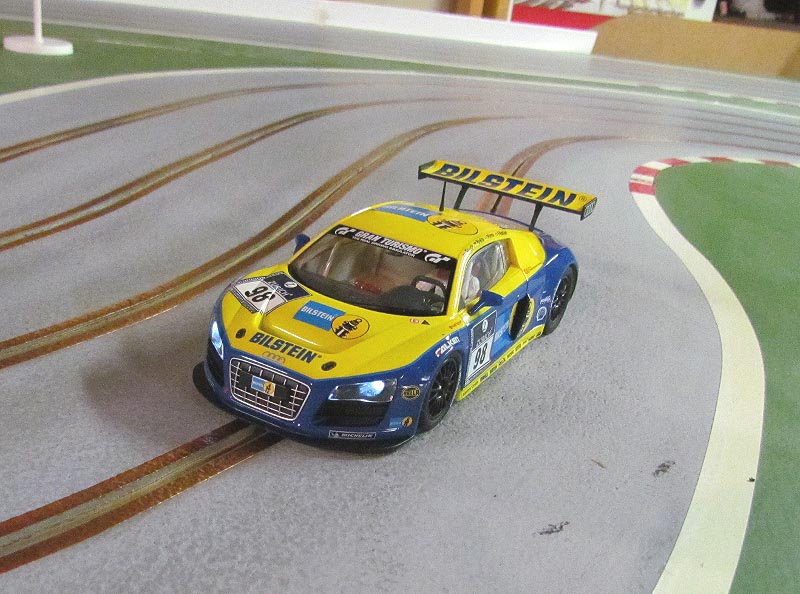
Even if the range of 1:24 cars isn’t as broad as the incredible diversity of 1:32, Carrera holds down the fort in this scale with several series: hot rods, vintage road racers (Ferrari 250 GTOs, Ferrari 250 GT ‘Breadvans’, Ferrari 330 P4s, Ford GT40 Mk IIs, Chevy Corvette Grand Sports, Cheetahs), modern GT cars (Audi R8s, Aston Martin DBR9s, Corvette C6Rs, Ferrari 575 GTs, Ferrari 599 XXs, Porsche GT3 RSRs), 1930’s streamliners (Auto Union Type Cs, Mercedes W125s, Maserati 4CLs), and modern LMP cars (Porsche RS Spyder, Audi R10). This doesn’t include any of their older models on the old style chassis – these cars listed all have the more recent drop-arm chassis, with shorter gearing for better acceleration. This could represent 50 or more different liveries, and in each class, it’s no problem to find 5 or 6 different cars to race against each other.
So, if your thrill in slot car racing is the speed, not much here for you to see. But if the game of close racing gets your blood pumping, these cars deliver in both analog and digital modes, and do it at a good price under $65.00 USD.
My thanks go to Scale Reproductions, Inc. in Louisville, KY. While no manufacturer has provided the car for review, Scale Reproductions gives club members a discount on slot car products, making it that much easier to bring you this review.
-Kurt